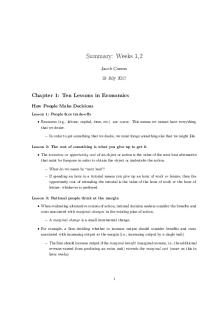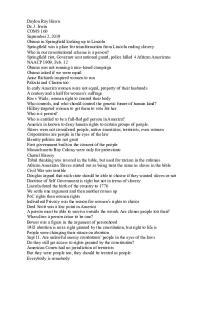Fineman Chap 1 Summary - The Thirteen American Arguments PDF

| Title | Fineman Chap 1 Summary - The Thirteen American Arguments |
|---|---|
| Author | Daylon Hawn |
| Course | Political Communication |
| Institution | California State University Sacramento |
| Pages | 2 |
| File Size | 82.3 KB |
| File Type | |
| Total Downloads | 88 |
| Total Views | 134 |
Summary
Chapter one summary and critique, Dr Irwin...
Description
Daylon Ray Hawn Dr. J. Irwin COMS 160 September 2, 2019 Obama in Springfield looking up to Lincoln Springfield was a place for transformation from Lincoln ending slavery Who in our constitutional scheme is a person? Springfield riot, Governor sent national guard, police killed 4 African Americans NAACP 1909, Feb. 12 Obama was not running a race-based campaign Obama asked if we were equal Anne Richards inspired women to run Paloski and Clinton too In early America women were not equal, property of their husbands A century and a half for women’s suffrage Roe v Wade, women right to control their body Who controls, and who should control the genetic future of human kind? Hillary targeted women to get them to vote for her Who is a person? Who is entitled to be a full-fledged person in America? America in known to deny human rights to certain groups of people. Slaves were not considered people, native americans, terrorists, even women Corporations are people in the eyes of the law Identity politics are not great First government built on the consent of the people Massachusetts Bay Colony were only for protestants Chattel Slavery Tribal thinking was revered in the bible, but used for racism in the colonies African American Slaves started out as being treat the same as slaves in the bible Civil War was terrible Douglas argued that each state should be able to choose if they wanted slaves or not Doctrine of Self Government is right but not in terms of slavery Lincoln dated the birth of the country to 1776 We settle one argument and then another comes up PoC rights then women rights Individual Privacy was the reason for women’s rights to choice Dred Scott was a low point in America A person must be able to survive outside the womb. Are clones people too then? When does a person cease to be one? Bower was a figure in the argument of personhood 1983 abortion is not a right granted by the constitution, but right to life is People were changing their stance on abortion Sept 11. Are unlawful enemy combatants’ people in the eyes of the laws Do they still get access to rights granted by the constitution? American Courts had no jurisdiction of terrorists But they were people too, they should be treated as people Everybody is somebody
Daylon Ray Hawn Dr. J. Irwin COMS 160 September 2, 2019 Fineman, Howard (2008). The Thirteen American Arguments: Enduring Debates That Define and Inspire Our Country. Random House: New York. The first chapter of the book goes into depth about the changes that the United States has experienced when it comes to human rights and civil rights. The author discusses the differences of society from the beginning of the colonies to Barack Obama’s presidential campaign. We are presented with ideas on how African Americans protested and fought for equal rights, and how women fought for equal rights. We discussed to mistreatment of Native Americans, African Americans, Mexican Americans, Asian Americans, enemy combatants, and women. The reader is able to tell that the author is advocating that everybody is somebody, and that means that everybody has rights. What we are left thinking is who has access to the rights granted by the constitution and what rights are granted by the constitution (Fineman, 2008). This is the debate that politicians and society have on a daily basis. In the first chapter of the book, the author explains many points about human rights and how they have changed over the course of our country (Fineman, 2008). In the eyes of the law, who is considered a person (Fineman, 2008)? That answer has not always been the same. The author does a good job at providing examples of how this answer has changed over time but does not take a personal stance on the issue and fails to provide a clear argument. The first chapter of the book lays out the framework for the reader to start asking, who is a person? The author provides excellent examples as to how the answer of this question is not plain and simple, but rather the answer is quite complex and is in flux (Fineman, 2008). The author presents information about the reasons behind pro-slavery and anti-slavery, and pro-choice and pro-life, thus allowing the reader to try and see why each side believes in what they do. The author also asks multiple questions, forcing the reader to think about who is considered a person and are all people treated equally (Fineman, 2008). The author does not take a stance on who should be considered a person and does not provide a clear argument for either side (Fineman, 2008). There are facts that are presented about both sides without there being any statement on which side should be considered favorable. The author states that everybody is somebody, and that means that everybody is entitled to rights, but the author does not explain what rights they should be entitled to (Fineman, 2008). Should they have access to the rights granted by the Constitution, or do they just have basic human rights? The author also makes statements about how equal rights for certain groups have been achieved, buy have they really (Fineman, 2008)? Do we live in a country that treats everybody as an equal, the answer is no. Overall, the first chapter does a great job at invoking thought about who is considered a person, and what rights they have access to, but fails to provide a clear argument or position. The author should take a stance on the issue and advocate for equal rights for all. In order for change to happen, everyone needs to work together to make it happen....
Similar Free PDFs

The American Revolution summary
- 5 Pages

Summary - Chap 1,2,3
- 6 Pages

Summary American Pastoral 2
- 81 Pages

Chap 6 summary - gvhj
- 3 Pages

Summary of American literature
- 8 Pages

Chap 43 Summary
- 3 Pages

Chap 1-5 Summary for Test 3
- 43 Pages
Popular Institutions
- Tinajero National High School - Annex
- Politeknik Caltex Riau
- Yokohama City University
- SGT University
- University of Al-Qadisiyah
- Divine Word College of Vigan
- Techniek College Rotterdam
- Universidade de Santiago
- Universiti Teknologi MARA Cawangan Johor Kampus Pasir Gudang
- Poltekkes Kemenkes Yogyakarta
- Baguio City National High School
- Colegio san marcos
- preparatoria uno
- Centro de Bachillerato Tecnológico Industrial y de Servicios No. 107
- Dalian Maritime University
- Quang Trung Secondary School
- Colegio Tecnológico en Informática
- Corporación Regional de Educación Superior
- Grupo CEDVA
- Dar Al Uloom University
- Centro de Estudios Preuniversitarios de la Universidad Nacional de Ingeniería
- 上智大学
- Aakash International School, Nuna Majara
- San Felipe Neri Catholic School
- Kang Chiao International School - New Taipei City
- Misamis Occidental National High School
- Institución Educativa Escuela Normal Juan Ladrilleros
- Kolehiyo ng Pantukan
- Batanes State College
- Instituto Continental
- Sekolah Menengah Kejuruan Kesehatan Kaltara (Tarakan)
- Colegio de La Inmaculada Concepcion - Cebu








